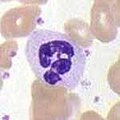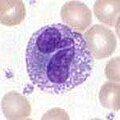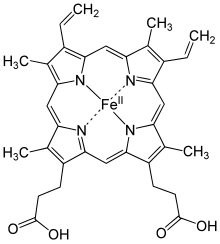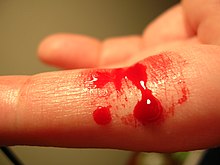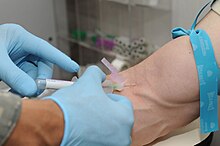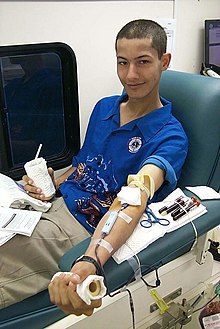blood

Blood ( Latin Sanguis , ancient Greek αἷμα haima ) is a body fluid that, with the support of the cardiovascular system, ensures the functionality of the various body tissues through various transport and connection functions. Blood is referred to as "liquid tissue ", sometimes also as "liquid organ ". Blood consists of special cells as well as the protein-rich blood plasma , which acts as a carrier for these cells in the cardiovascular system.
Blood is primarily pumped through the body's blood vessels in a circulatory system through mechanical action of the heart . Venous valves in combination with muscle work have a supportive effect . The vessels that lead away from the heart are called arteries and those that lead back to the heart are called veins . The vascular system of the adult human body contains around 70 to 80 ml of blood per kg of body weight, which corresponds to around 5 to 6 liters of blood. On average, men have about 1 liter more blood than women, which is mainly due to differences in size and weight.
Because of the similarities in function, blood is similar in all vertebrates . Existing differences between human and animal blood are pointed out in the article. For differences in the structure and function of the cellular components of the blood, reference is made to the relevant article.
The loss of blood is known as bleeding (from Middle High German bluoten ) or bleeding .
etymology
The common Germanic word “blood” (from Middle High German and Old High German bluot ) probably belongs to Indo-European bhlê- “source”, and bhel- “swell, bud, bloom” (compare English blow ) in the sense of “flowing” . According to old tradition, blood is considered the seat of life, which is why compositions such as blood revenge and blood guilt emerged .
evolution
In order to maintain its metabolism, every cell is dependent on material exchange with its environment. Since with the development of more complex multicellular cells, not every cell is in direct contact with the body surface and diffusion is a very slow process, the time requirement of which is proportional to the square of the distance, a transport medium for these exchange processes becomes necessary with increasing size of the living being. This liquid brings the substances close to the target cells and thus shortens the necessary diffusion distance.
In animals with open blood circulation (e.g. arthropods or mollusks ), blood and interstitial fluid (fluid in the interstitial space ) are not separated from one another. The fluid that circulates here is known as the hemolymph . Insects compensate for the disadvantage of the relatively slow blood flow in an open circuit by the fact that the hemolymph does not serve to transport oxygen, but rather this is ensured by the trachea . In all animals with a closed blood circulation, including all vertebrates , the circulating fluid is called "blood".
Composition and properties
Blood consists of cellular components ( hematocrit , approx. 44%) and plasma (approx. 55%), an aqueous solution (90% water) made of proteins , salts and low-molecular substances such as B. Monosaccharides (simple sugars). Other components of the blood are hormones , dissolved gases and nutrients ( sugar , lipids and vitamins ) that are transported to the cells, and metabolic and waste products (e.g. urea and uric acid ) that are transported by the cells to their places of excretion.
From a chemical-physical point of view, blood is a suspension , i.e. a mixture of the liquid water and cellular components. It is a non-Newtonian liquid . This is the reason for its special flow properties. Because of the erythrocytes it contains, blood has a higher viscosity than plasma . The higher the hematocrit value and the lower the flow velocity, the more the viscosity increases. Due to the deformability of the red blood cells, blood no longer behaves like a cell suspension when the flow rate increases, but rather like an emulsion . The pH value of human blood is 7.4 and is kept constant by various blood buffers . If it falls below a certain limit (approx. 7.35), one speaks of acidosis (over-acidification), if it is too high (approx. 7.45), this is called alkalosis .
Blood owes its red color to the hemoglobin, more precisely to its oxygen-binding part, the heme group . That is why hemoglobin belongs to the group of blood pigments . Oxygenated blood has a lighter and stronger color than oxygen-deficient blood because the heme group undergoes a conformational change after the oxygen has been absorbed , in which the position of the iron in the heme group changes relative to its binding partners. This results in a change in the absorption spectrum of the light.
The aldehyde trans-4,5-epoxy- (E) -2-decenal was identified in 2014 as the chemical component that makes up the typical metallic smell of blood in mammals and attracts predators .
If blood leaks into the tissue through an injury to blood vessels, the hemoglobin slowly decomposes into the bile pigments ; in a chronological sequence of several days, a “blue spot” turns green and yellow. Lizard species live in New Guinea whose blood has such a high biliverdin concentration that they appear green on the outside. The body color of jaundice in humans is due to high bilirubin levels.
plasma
The ions contained in the plasma are mainly sodium , chloride , potassium , magnesium , phosphate and calcium ions. The proportion of proteins is around 60 to 80 g / l, corresponding to 8% of the plasma volume. They are divided into albumins and globulins according to their mobility during electrophoresis . The latter are in turn divided into α 1 , α 2 , β and γ globulins. The plasma proteins take on the tasks of transporting substances, immune defense , blood clotting , maintaining the pH value and osmotic pressure .
Blood plasma without clotting factors is called blood serum . Serum is obtained by centrifuging the blood in a tube after it has completely clotted . In the lower part of the tube there is the so-called blood cake , in the upper part the mostly clear liquid called serum. The serum also contains substances that are not found in the plasma: in particular growth factors such as PDGF , which are released during the clotting process. Serum consists of 91% water and 7% protein. The rest are electrolytes, nutrients, and hormones. It is yellowish in color due to dissolved bilirubin .
Cellular components
The cells in the blood are divided into erythrocytes , which are also called red blood cells , leukocytes , which are known as white blood cells , and thrombocytes or platelets . Blood has a corpuscular proportion (cell proportion) of 44 to 46% in men and 41 to 43% in women. Since the hemoglobin-bearing erythrocytes make up the majority of the corpuscular blood, this ratio is called hematocrit . The hematocrit is approx. 60% in newborns and only 30% in small children. By puberty it then rises to the values for adults. Strictly speaking, the hematocrit only describes the proportion of erythrocytes. After centrifuging the cellular components, the leukocytes and thrombocytes can be observed as a fine, light-colored fluff (buffy coat) over the erythrocytes located at the bottom (hematocrit) and under the plasma fraction; they make up less than 1% of the blood volume in healthy people.
| designation | Number per μl of blood | ||
|---|---|---|---|
| Erythrocytes | 4.5 to 5.5 million | ||
| Leukocytes | 4,000-11,000 | ||
| Granulocytes | |||
| Neutrophils | 2,500-7,500 | ||
| Eosinophils | 40-400 | ||
| Basophils | 10-100 | ||
| Lymphocytes | 1,500-3,500 | ||
| Monocytes | 200-800 | ||
| Platelets | 300,000 | ||
The erythrocytes or red blood cells are used to transport oxygen and carbon dioxide . They contain hemoglobin , a protein that is responsible for binding and transporting oxygen in the blood and consists of the actual protein globin and the heme group, which forms a complex with iron . This iron gives the blood of vertebrates its red color ( see also : blood pigment ). In other animals such as cephalopods , arachnids or crustaceans , a copper compound ( hemocyanin ) fulfills this function. That's why their blood is bluish. About 0.5 to 1% of red blood cells are reticulocytes , i.e. erythrocytes that are not yet fully mature.
The leukocytes or white blood cells are further divided into eosinophils , basophils and neutrophils, granulocytes , monocytes and lymphocytes . The granulocytes are named after the coloring behavior of their protoplasm and, like the monocytes, serve the unspecific immune defense , while the lymphocytes participate in the specific immune defense. Platelets stop bleeding and thus form the basis of the first phase of wound healing .
The numerical composition of the blood cells can vary between the individual vertebrate species. Goats have particularly high erythrocyte counts (up to 14 million / µl), poultry particularly low (3–4 million / µl). The leukocyte counts have similarly large variations: cattle , horses and humans have around 8,000 / µl, while sheep (up to 17,000 / µl) and birds (up to 25,000 / µl) have particularly high proportions of white blood cells. The proportion of the individual subtypes of leukocytes also varies considerably. While in humans and horses the granulocytes dominate (granulocytic blood count) , in cattle it is the lymphocytes (lymphocytic blood count) ; in pigs the ratio of granulocytes to lymphocytes is balanced (granulo-lymphocyte blood count) .
Build-up and breakdown of the cells of the blood
All cells in the blood are formed in the bone marrow in a process called hematopoiesis . Pluripotent stem cells , from which any cell can mature, become multipotent stem cells that are tied to different cell lines. The individual cellular components of the blood then develop from these.
The erythropoiesis called distinction for hematopoiesis only the differentiation of stem cells into erythrocytes. The process of cell maturation and proliferation is promoted by the hormone erythropoietin produced in the kidneys and liver . Iron , which is required for the formation of hemoglobin, plays an important role in erythropoiesis . Vitamin B 12 ( cobalamine ) and folic acid also play a role. If there is a lack of oxygen in the body, for example due to a stay at high altitude, the hormone release is increased, which in the long term leads to an increased number of red blood cells in the blood. These can transport more oxygen and thus counteract the deficiency. This counter-regulation process can also be measured: an increased number of reticulocytes (immature red blood cells) is found.
The breakdown of the red blood cells takes place in the spleen and the Kupffer cells of the liver. Erythrocytes have an average lifespan of 120 days. The hemoglobin is broken down in a breakdown process over several steps (via bilirubin ) to urobilin and sterkobilin . While urobilin colors the urine yellow, Sterkobilin is responsible for the typical color of the faeces .
Functions
Transport function
The blood with its individual components fulfills many essential tasks in order to maintain the life processes. The main task is the transport of oxygen and nutrients to the cells and the removal of metabolic end products such as carbon dioxide or urea . In addition, hormones and other active substances are transported between the cells. Blood also serves for homeostasis , i.e. the regulation and maintenance of the water and electrolyte balance, the pH value and the body temperature.
Defense function
As part of the immune system , the blood has tasks in protecting and defending against foreign bodies (unspecific defense) and against antigens (specific defense) through phagocytes (scavenger cells) and antibodies . The blood is also an important component in the response to injuries ( blood clotting and fibrinolysis ). Blood also has a supportive effect through the fluid pressure it exerts.
Thermoregulation
The constant circulation of the blood ensures a constant body temperature . In healthy people, this is around 36–37 ° C. This is generally based on the temperature inside the body.
breathing
One function of the blood is to transport oxygen from the lungs to the cells and carbon dioxide - the end product of oxidative carbon change - back to the lungs.
During breathing , the oxygen contained in the air reaches the lungs via the windpipe and reaches the lungs . The oxygen reaches the blood vessels through its thin membrane . The blood, in turn, is carried from the heart to the lungs as part of the pulmonary circulation . The initially oxygen-poor blood releases carbon dioxide (CO 2 ) in the lungs and takes in oxygen there. The now oxygen-rich blood flows through several pulmonary veins (pulmonary veins) back to the heart, more precisely to the left atrium. From there the blood is distributed to most of the metabolic cells within the body via a closed network of blood vessels (see also blood circulation ). Exceptions are u. a. Cells of the cornea of the eye and of the cartilage that have no direct connection to the vascular system and, as in more primitive organisms, are nourished by diffusion ( bradytrophic tissue).
The blood pigment hemoglobin contained in the red blood cells is functionally important for the gas exchange described above .
Each hemoglobin molecule consists of four subunits, each containing a heme group. An iron ion is bound in the center of the heme group . This iron exerts a strong attraction (so-called affinity ) for oxygen, which binds the oxygen to the hemoglobin. If this has taken place, one speaks of oxygenated hemoglobin. The affinity of the hemoglobin for oxygen is increased by an increase in the blood pH, a decrease in the partial pressure of carbon dioxide, a lower concentration of the 2,3- bisphosphoglycerate formed in the Rapoport-Luebering cycle and a lower temperature. If the affinity of hemoglobin for oxygen is high and the partial pressure of oxygen is high, as is the case in the lungs, then this favors the binding of oxygen to hemoglobin, but if the opposite is the case as in body tissue, oxygen is released.
98.5% of the oxygen in the blood is chemically bound to hemoglobin . Only the remaining 1.5% are physically dissolved in the plasma . This makes hemoglobin the primary transport of oxygen in vertebrates . Under normal conditions, about 96-97% of the hemoglobin exiting the lungs in humans is saturated with oxygen. Deoxygenated blood is still approximately 75% saturated. The oxygen saturation is the ratio of actual oxygen bound to the maximum possible bound oxygen. Carbon dioxide is transported in the blood in different ways: the smaller part is physically dissolved in the plasma, but the main part is transported in the form of hydrogen carbonate (HCO 3 - ) and as carbamate bound to hemoglobin . The conversion of carbon dioxide to hydrogen carbonate is accelerated by the enzyme carbonic anhydrase .
Hemostasis and coagulation
The processes that are supposed to protect the body from bleeding are summarized under the umbrella term of hemostasis. A distinction is made between primary and secondary hemostasis.
In addition to platelets, various factors contained in the plasma and presented on the vessel wall are involved in primary hemostasis . The interaction of these components leads to the sealing of leaks in the vessel wall after just two to four minutes. This time value is also known as the bleeding time . First the vessel constricts, then the platelets clog the leak, and finally a solid plug of fibrin forms , which contracts when the clotting is complete. The fibrinolysis is later responsible for a re freeing the vessel.
The secondary hemostasis is different by the cooperation of coagulation factors instead. Except for calcium (Ca 2+ ), these are proteins synthesized in the liver . These factors, which are normally inactive, are activated in a cascade . They can be activated either endogenously , i.e. through contact of the blood with anionic charges of the subendothelial collagen (located under the inner surface of the vessels ) , or exogenously , i.e. through contact with tissue thrombokinase , which has entered the bloodstream through major injuries. The aim of secondary blood coagulation is the formation of water-insoluble fibrin polymers that allow the blood to clot into "clots".
As fibrinolysis , the process of reformation of the fibrin clot is called. This takes place through the action of the enzyme plasmin .
Anticoagulants (anticoagulants) are used if the blood's ability to clot is to be reduced due to various medical indications such as cardiac arrhythmias . These work by either binding the calcium required for coagulation (but only in the test tube, e.g. citrate or EDTA ), by inhibiting the interaction between the coagulation factors (e.g. heparin ) or by preventing the formation of the coagulation factors themselves prevent (e.g. coumarins ).
Medical aspects
Diseases
Many diseases can be recognized by certain changes in the blood components in the blood count and classified according to their severity, which is why the blood is the most frequently examined body fluid in laboratory medicine . Another important investigation is the erythrocyte sedimentation reaction (BSR), in which conclusions can be drawn about inflammation that may be present based on the time it takes for the solid components to settle in blood treated with anticoagulants.
In addition to diseases that manifest themselves through changes in the blood count, there are also diseases that affect the blood (or blood components) itself. The specialty of medicine that deals with these disorders is hematology . The most important include anemia or anemia , haemophilia or hemophilia and leukemia as blood cancer . In the case of anemia, the body is insufficiently supplied with oxygen ( hypoxia ) for a variety of reasons . With haemophilia, blood clotting is disturbed, which results in bleeding that is difficult or impossible to control. In leukemia, excessive white blood cells are produced and expelled in unfinished forms. This leads to a displacement of the other cellular components of the blood into the bone marrow and blood itself.
An excessive formation of blood cells is called cytosis or philia , which, depending on the type of cell, is divided into erythrocytosis and leukocytosis (sub-forms are granulocytosis : eosinophilia , basophilia , neutrophilia ; monocytosis ; lymphocytosis ; thrombocytosis ). A deficiency in red blood cells is called erythropenia (anemia), in white leukopenia (depending on the cell type, eosinopenia , basopenia , neutropenia , monopenia , lymphopenia , thrombocytopenia ). Such shifts in the proportions of the number of cells are examined in the differential blood count and in some cases provide information about the type and stage of a disease.
Due to the role of the blood in supplying the cells, there is always a risk of cell damage or death if there is no or insufficient blood supply. A body-wide insufficient supply of blood, for example due to a large blood loss, is called shock . Blood clots (but also other causes) can lead to a thrombosis , embolism or a heart attack (e.g. heart or cerebral infarction ). To prevent this, active ingredients such as acetylsalicylic acid , heparin or phenprocoumon can be used, which inhibit coagulation.
Blood itself has a laxative effect when it enters the gastrointestinal tract in large quantities.
Blood types
Glycolipids , which act as antigens , are anchored in the cell membrane of the red blood cells . They are known as blood types. If blood from different blood groups mixes, the blood often clumps. Therefore, the blood type of the donor and recipient must be determined prior to blood transfusions in order to avoid potentially fatal complications. The medically most important blood groups in humans are the AB0 system and the Rhesus factor (both first described by Karl Landsteiner and colleagues). However, there are around 20 other blood group systems of lesser importance in humans that can also cause complications.
In AB0 system is found the blood groups A , B , AB and 0 . The designation states which antigens are found on the erythrocytes (for A: only A antigens, for B: B antigens, for AB: A and B antigens and for 0: none of the two) and which antibodies (des IgM type ) are present in the serum (for A: B antibodies, for B: A antibodies, for AB: no antibodies and for 0: A and B antibodies).
Rhesus factors may in the subgroups C , D and E occur. Factor D is particularly relevant from a medical point of view. If the D antigen is present, it is called rhesus-positive ; if it is missing, it is called rhesus-negative . In the rhesus system, the antibodies (of the IgG group ) only arise in the blood after the body has encountered blood with antigens for the first time. Because IgG antibodies can cross the placenta , there is a potential for complications during the second pregnancy of a Rh-negative mother with a Rh-positive child. This initially leads to a dissolution ( hemolysis ) of the child's erythrocytes and a subsequent pathologically increased formation, which is referred to as fetal erythroblastosis .
In addition to their relevance in transfusions and organ transplants as well as in pregnancy, blood groups are also of importance in forensic medicine for determining identity and kinship, even if the informative value of tests based on them is far less than that of DNA analysis and is limited to proof of exclusion.
Blood transfusions
With large blood losses, with various diseases such as myelodysplastic syndrome and often to combat side effects with all chemotherapies , blood transfusions are usually carried out to replenish the blood volume or to supplement certain blood components that are deficient. It should be noted here that the blood of the donor and recipient must meet certain conditions with regard to blood groups and the Rhesus factor , otherwise serious transfusion incidents can occur. However, blood donations are necessary to enable transfusions .
A distinction is made between whole blood donations , autologous blood donations and donations of only individual specific blood components (e.g. blood plasma or platelets). In the case of a whole blood donation, approx. 500 ml of venous blood are taken from the donor; this blood is then preserved , examined and, if appropriate, separated into various blood products. These are stored in a blood bank . Autologous blood donations serve to provide blood before an operation, which can be re-administered to the patient without complications if blood loss occurs.
A blood donation costs the recipient or their health insurance company in Germany € 109.90. The main component of this amount is the execution of the blood donation, further cost items are laboratory tests, preservation, distribution and administration.
Alternatives to donating blood are artificial blood , which consists of long-life, freeze-dried red blood cells in an isotonic solution, and blood substitutes , which are used to compensate for excessive blood loss when no blood reserves are available. Blood substitutes can either dilute the remaining blood and thus restore the volume necessary for a functioning blood circulation (so-called volume expanders ) or support the blood by actively taking over the oxygen transport.
The other mammals also have different blood group systems (7 to 15 in domestic animals), each with a plurality of blood group factors. In contrast to humans, however, there are hardly any reactions to these blood group differences during the first blood transfusion. Antibodies formed as a result may only cause an intolerance reaction with subsequent blood donations .
Bloodletting and cupping

Starting from antiquity, blood was considered one of the four juices of life in the European Middle Ages . Attempts were made to heal by bloodletting or cupping and to remove “rotten blood”. According to stories, this consideration resulted from observing sick hippos rubbing against objects until they bleed.
For a long time, bloodletting was considered a recognized form of therapy and enjoyed great popularity. However, many doctors and surgeons tended to use this form of therapy extremely excessively. Only research and contact with other cultures (especially with the highly developed Arabic medicine ) ensured differentiated and more application-oriented treatments.
Bloodletting as therapeutic blood sampling is nowadays carried out by puncturing a vein with a thick cannula . As a rule, 400 to a maximum of 1,000 ml are withdrawn. This is still indicated for diseases such as hemochromatosis (iron storage disease), porphyria cutanea tarda and polycythaemia vera (abnormal proliferation of red blood cells in particular).
The leech treatment is also receiving attention again - although the controlled pharmacognostic use of hirudin is paramount.
Blood poisons
Blood toxins, also known as hemotoxins, are substances whose chemical composition changes the blood, blood coagulation or blood formation system in such a way that the transport and metabolic function of the blood is restricted or prevented. This can damage the blood circulation and even lead to circulatory collapse. The chemical compounds that act as blood poisons include, for example, carbon monoxide (CO), benzene , alcohols such as ethanol , organic nitro compounds , arsenic and lead compounds. Examples of herbal ingredients with hemotoxic effects are the saponins and quinine . A number of animal poisons also act on the blood, for example the main components of the poisons of many species of viper .
Blood purification
Options for removing blood toxins are dialysis in the case of acute or chronic kidney failure or apheresis to remove pathogenic ( disease -causing) components.
Cultural history of the blood
Early on, blood was seen as the carrier of life force. The observation of how when a person bleeds to death or when a slaughtered animal bleeds to death, the people can conclude that blood is a primal substance of life.
Blood as a waste product in animal production
| Animal species | Blood percentage (%) |
|---|---|
| lambs | 4-9 |
| Bovine | 2,4-6 |
| Pigs | 2-6 |
| Chicken | 1.4-2.3 |
Blood is considered one of the more problematic waste products from slaughterhouses . For the USA, an annual production of 1.6 million tons of blood is estimated (with a share of around 20% of the global meat market). Because of the relatively high solids content (around 18%) and the high chemical requirement for oxygen (around 500 g O 2 / L, around 800 times as much as in household waste water), the environmental problems caused by slaughter blood are considered in the specialist literature as "enormously". Because of the disposal costs, manufacturers have a strong economic incentive to process or recycle blood. About 30% of the resulting blood (in the USA) is fed into the food industry , mainly as a cost-effective binding agent in meat products and as a coloring agent . Blood is also used for animal feed , as fertilizer and in paper processing as an adhesive .
Blood as a food / nutrient
Although be at or after the slaughter opened animal body and so suspended that they bleed out and so give tougher meat, but blood is on the other hand also as a food ingredient, such as used by pudding.
Blood is also the staple food for some so-called haematophagous (blood-consuming) parasites . The leech sucks on the skin and then bites its way through it. Leeches can absorb five times their weight in blood within half an hour. The anticoagulant substances excreted with their saliva (e.g. heparin and hirudin ) also make them interesting for medicine. Other bloodsuckers include mosquitoes , horseflies , some mites (e.g. red poultry mite ), bed bugs and some worms (e.g. hooked suction worms ). Few vertebrates feed on blood in whole or in part. In addition to the vampire bats , only the populations of the pointed-billed ground finch ( Geospiza difficilis ), a Darwin finch , living on Wolf and Darwin, the two northernmost Galápagos Islands , are known for such parasitism. In waterless islands this "vampire finch" so-called drinking the blood of up staying there seabirds by unnoticed the approaches of quills anpicken and so at the same time meet their fluid needs. Blood-sucking animals are often carriers of disease because, as vectors, they can transmit disease-causing viruses , bacteria , protozoa and other organisms. Some of these microorganisms transferred in this way live directly from the host organism's blood, such as the unicellular malaria pathogens, the plasmodia .
After the death of an organism and the collapse of the immune system, putrefactive bacteria , which are otherwise unable to reproduce in the living organism, begin to metabolize the blood most clearly, releasing biogenic amines such as cadaverine and putrescine , and thus lead to the definite sign of death in the vein network that penetrates through , so to discolour the superficial venous system in a dark green.
Other use
Human blood is mentioned in medieval literature as animal feed in pig fattening, as garden fertilizer and in various recipes from the household and construction industry. These strange today use is in on the bloodletting established pharmaceutical justified medicine of the Middle Ages and the early modern period, was available through the human blood in some substantial quantities. But like the bathing system as a whole, this practice - for ideological as well as for hygienic reasons - was partly only tolerated as a custom of the poor people, or was strongly opposed.
Blood agar is a culture medium used in microbiology for microorganisms that contains human or animal blood. Various pathogens, such as streptococci , can be detected with it.
Blood meal , which is obtained from the dried blood of slaughtered animals, is still sometimes used as a protein additive in animal feed . With the advent of BSE , blood meal can only be produced from blood from slaughterhouses that do not slaughter ruminants (Regulation (EC) No. 1234/2003). Blood meal is mainly used to feed fish or as a fertilizer .
Oxblood is a binding agent for paint coatings that used to protect timber framing from the weather. Contrary to popular belief, this color is not called ox blood red because it is reddish, but because it actually contains ox blood. For the production of ox blood red, the blood of freshly slaughtered ox is allowed to stand so that the serum and the red blood cells separate. With the addition of pigments, a weatherproof color is obtained from the serum and slaked lime .
See also
literature
- Christina von Braun, Christoph Wulf: Myths of the blood. Campus Verlag, Frankfurt am Main u. a. 2007.
- Ludwig Heilmeyer , Herbert Begemann: blood and blood diseases. In: Ludwig Heilmeyer (ed.): Textbook of internal medicine. Springer-Verlag, Berlin / Göttingen / Heidelberg 1955; 2nd edition, ibid. 1961, pp. 376-449.
- Arnold Angenendt : Atonement through blood. In: Early Medieval Studies . 18, 1984, pp. 437-467.
- Robert F. Schmidt, Florian Lang, Gerhard Thews : Human Physiology . Springer, Berlin 2004, ISBN 3-540-21882-3 .
- Friedhelm Schneidewind: The lexicon all about blood - the red juice of life in mysticism and mythology, magic and medicine, religion and popular belief, legend and literature. Lexikon-Imprint-Verlag, Berlin 1999, ISBN 3-89602-224-5 .
- Meinolf Schumacher : Sin filth and purity of heart. Studies of the imagery of sin in Latin and German literature of the Middle Ages. , Wilhelm Fink Verlag, Munich 1996, ISBN 3-7705-3127-2 ( digitized version), pp. 408-416 (dirt: blood) , pp. 552-588 (cleaning with blood) .
- Christina von Braun : fourth picture: blood and bloodshed . On the importance of blood in the anti-Semitic world of thought. In: Julius H. Schoeps , Joachim Schlör (eds.): Images of hostility towards Jews . Anti-Semitism - Prejudices and Myths. Augsburg 1999, ISBN 3-8289-0734-2 , pp. 80-95.
- Stefan Silbernagl, Agamemnon Despopoulos: Pocket Atlas of Physiology . Thieme, Stuttgart 2003, ISBN 3-13-567706-0 .
- Paul Volz : The biblical antiquities. Komet Verlag, Cologne 1914, ISBN 3-89836-316-3 .
- Christine Knust, Dominik Groß (Ed.): Blood. The power of the very special juice in medicine, literature, history and culture (= studies of the AKGW. Volume 7). Kassel 2010, ISBN 978-3-89958-832-3 .
- Jan Steinmetzer, Dominik Groß: License claims on blood products - The business with patents on blood tests. In: Jochen Taupitz (Ed.): Commercialization of the human body. Conference proceedings (annual conference of the Academy for Ethics in Medicine), Berlin 2007, ISBN 978-3-540-69894-4 , pp. 213-226.
Web links
- electron microscopic images of blood cells
- Bio revision course: blood - with questions and answers
- Red Gold - The epic story of blood - Page around the blood
- Pedro Silva: Blood and blood cells (English)
- Blood - the very special juice . (PDF; 1003 kB) Quarks & Co
Individual evidence
- ^ The dictionary of origin (= Der Duden in twelve volumes . Volume 7 ). 5th edition. Dudenverlag, Berlin 2014, p. 178 . See also Friedrich Kluge : Etymological dictionary of the German language . 7th edition. Trübner, Strasbourg 1910 ( p. 61 ).
- ↑ Attractant identified: the smell of blood. In: Spiegel Online . November 12, 2014, accessed November 12, 2014.
- ↑ S. Nilsson, J. Sjöberg, M. Amundin, C. Hartmann, A. Buettner and a .: Behavioral Responses to Mammalian Blood Odor and a Blood Odor Component in Four Species of Large Carnivores . In: PLoS ONE. 9 (11), 2014, p. E112694. doi: 10.1371 / journal.pone.0112694 (English).
- ↑ The green blood of the lizards orf.at, May 17, 2018, accessed on May 17, 2018.
- ↑ Three hearts, blue blood and much more - the "juice of life". In: Scinexx the knowledge magazine.
- ↑ No business with charity . ( Memento from June 18, 2006 in the Internet Archive ) DRK blood donation service, June 24, 2006.
- ↑ Heike Petermann: Blood - Myth, Magic, Medicine . Medical Scientific Publishing Company, Berlin 2014, p. 37.
- ↑ Heike Petermann: Blood - Myth, Magic, Medicine . Medical Scientific Publishing Company, Berlin 2014, p. 40.
- ↑ Statistics ( memento of April 4, 2012 in the Internet Archive ) at usda.gov. The proportion is higher for chickens and pigs, but lower for cattle.
- ↑ Fidel Toldrá, Leo M. L Nollet: Handbook of analysis of edible animal by-products . CRC Press, Boca Raton 2011, ISBN 978-1-4398-0360-8 , pp. 14th ff .




